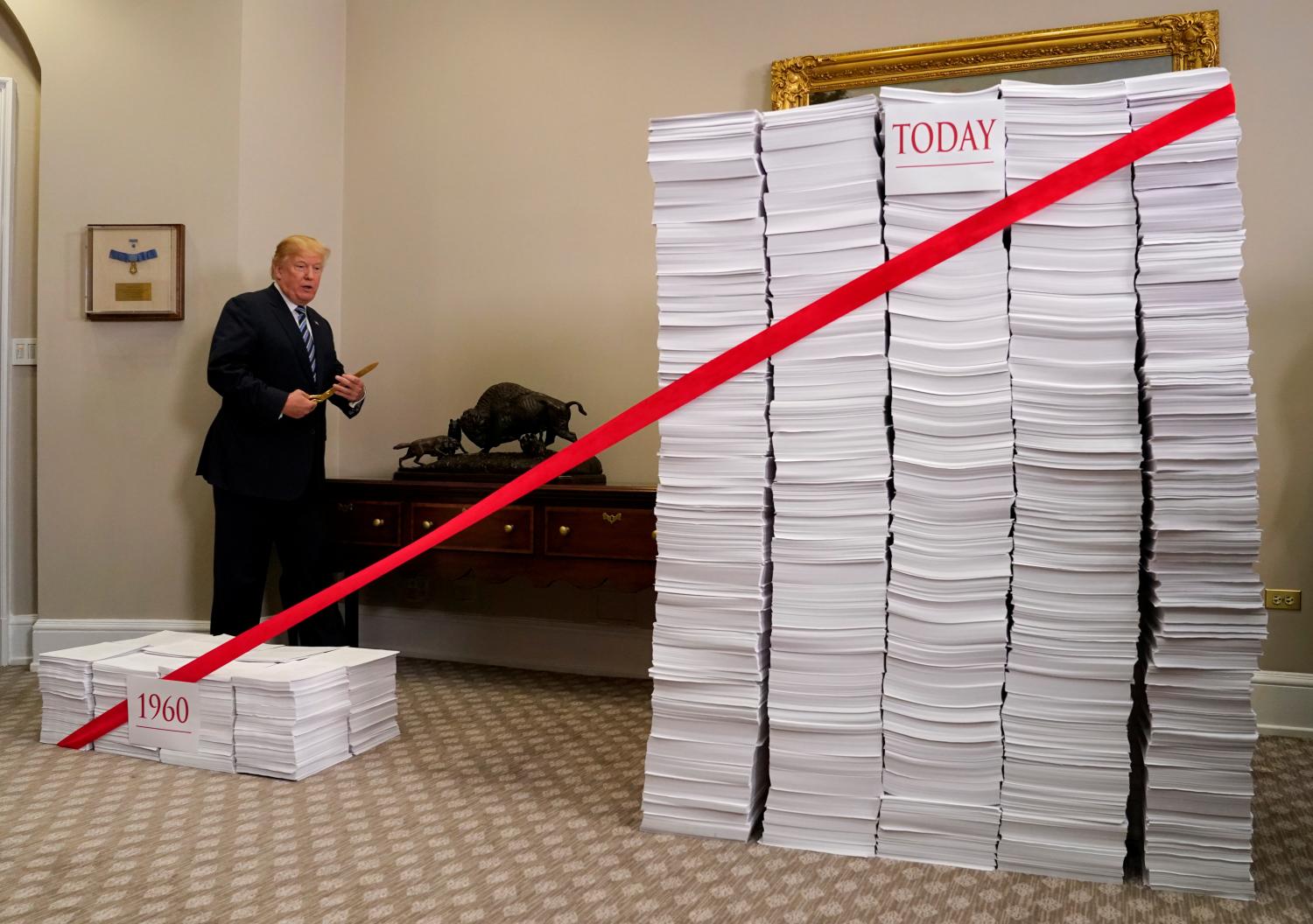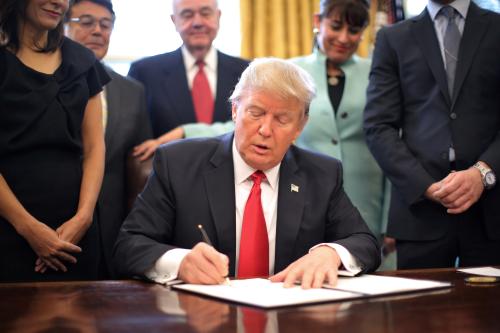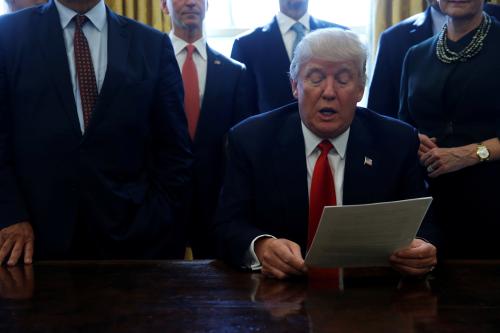This report is part of the Series on Regulatory Process and Perspective and was produced by the Brookings Center on Regulation and Markets.
Deregulation has been hailed as one of the Trump administration’s top policy accomplishments. This begs the obvious question: how much deregulation has actually happened under Trump? Deregulation can be understood and measured in different ways. It may mean taking old rules off the books or modifying them to be less stringent, an effort tracked by Brookings. Alternatively, it may mean halting issuance of new rules altogether. This latter measure is especially appropriate for the first year of an administration because blocking issuance of rules can be done relatively quickly while issuing new deregulatory rules takes far more time and effort. Most new rules—including those that revise or eliminate existing rules–must be drafted, issued for public comment, and finalized, a process that typically takes longer than a year. Issuing new deregulatory rules is especially difficult in the first year of an administration, a time when many key political appointees are not yet on board to direct policymaking.
This piece therefore analyzes the extent to which the Trump administration reduced rulemaking output relative to the Obama and Bush administrations. How much did Trump reduce rulemaking across the government? Was Trump more successful in slowing the issuance of rules in the Cabinet agencies his appointees directly administer than at independent agencies (which enjoy greater autonomy from the White House)? Did Trump particularly reduce the number of important (“major”) rules relative to those that were less important? Were changes more pronounced at any particular agencies?
Analyzing these questions provides a more complete and more nuanced look at the Trump administration’s influence on the rulemaking process and the regulatory state. On a practical level, it provides more detail on the administration’s actual impact on the rulemaking process. On a theoretical level, it provides insight into the degree to which agency independence may temper (or enhance) presidential influence over rulemaking.
This piece finds that agencies under Trump significantly reduced the total amount of rulemaking relative to prior administrations across the board. This drop held for both routine rules and important rules, and for both Cabinet agencies and independent agencies.1 These results are somewhat surprising and contrary to expectations that the new administration would: 1) achieve a greater drop in Cabinet agencies (which are thought to more closely reflect White House priorities), and 2) focus on reducing important rules as opposed to rules more generally. The reasons for the broader drop therefore merit further study.
The Mechanics of Rulemaking
Agencies initiate rulemaking in response to many different forces. Agencies issue some rules to comply with statutory mandates. Some statutes require agencies to periodically issue a new rule (say an annual quota for hunting or fishing). Rulemaking along these lines is difficult for any administration to stop, as it is both legally required and also generally expected and relied upon by the public. Such rules appear to be a sizeable portion of the total rulemaking in 2017. Other rules are prompted by regulated entities, interest groups, and agency staff ideas. Many rules make incremental changes, correcting or building upon existing rules. In rare cases, a court or even the White House pushes an agency to issue a rule.
As noted, rules must generally be proposed for public comment before being finalized. Agencies in the Trump administration therefore inherited rules that were proposed but not finalized under the Obama administration. If these rules were not required by statute or court order, the Trump administration could generally decline to finalize them through mere inaction. Indeed, the Trump administration indicated plans to do just that for 469 rules proposed by the Obama administration. These numbers later increased as more targets for withdrawal were identified. Challenging agencies in court for declining to finalize discretionary rules is difficult as agencies generally hold broad discretion over their priorities and courts are reluctant to direct agencies to work on discretionary rules.
Consider one example. Under Obama the Federal Motor Carrier Safety Administration (housed within the Department of Transportation) requested early feedback in 2016 on whether to require people in safety-sensitive positions on trains and trucks to be tested for obstructive sleep apnea. This request was intended to build the basis for a proposed rule, which would then be finalized. Obstructive sleep apnea disorder is thought to increase the risk of drowsiness, which would pose a danger to air and rail passengers. The Trump administration withdrew this idea in 2017, concluding that existing safety standards were adequate. The rulemaking project therefore died, resulting in issuance of one fewer rule. Supporters of issuing a rule in this area could file a rulemaking petition, but a court would likely accept the agency’s denial of such a petition if it provided a reasonable basis.
Data and Analysis
To analyze changes in rulemaking output under Trump, this piece draws on data from the Government Accountability Office’s (GAO) Federal Rules Database. The Congressional Review Act requires agencies submit all rules with an accompanying report to the GAO, which in turn submits these reports to relevant congressional committees. The Federal Rules Database includes all rules submitted pursuant to this legally required process, providing the most comprehensive look at rulemaking activity. The GAO’s database captures two important classifications that are useful in thinking about the nature of rulemaking output.
Major rules are more likely than their non-major counterparts to be of greater political, policy, and perhaps legal importance.
First, did the Office of Management and Budget’s (OMB) regulatory office classify the rule as “major” under the Congressional Review Act? A “major rule” is generally classified as having a $100 million annual impact on the economy. The GAO has a comprehensive list of major rules, as it is tasked under the Congress Review Act with compiling reports on such rules. Major rules are more likely than their non-major counterparts to be of greater political, policy and perhaps legal importance. Such rules are generally more contentious and more likely to attract attention from the White House, Congress, interest groups, and courts. They are therefore a proxy (albeit rough) of the importance of rulemaking activity.
Second, did the rule come from an “executive agency” or an “independent agency”? As noted above, executive agencies (as defined by this piece) include the departments that sit in the Cabinet such as the Department of Agriculture or Department of Energy as well as the Environmental Protection Agency. By contrast, independent agencies are located outside the Cabinet. Examples include the Federal Deposit Insurance Corporation, the Federal Trade Commission, and the Small Business Administration. As noted above, executive agencies theoretically should be more responsive to the president’s rulemaking priorities than independent agencies, which are generally more insulated from the White House.
The research approach has four notable limitations. First, counts of rules issued do not shed light on whether the rules imposed additional regulation or were deregulatory. This problem is largely mitigated by the fact that the Trump administration did not have time in 2017 to draft, propose, and formulate deregulatory rules. Second, the classifications of “major” and “non-major” are relatively blunt proxies for the policy importance and scope of a rule. The data therefore do not capture if an agency changed its rulemaking practice and begun issuing larger rules instead of multiple smaller discrete rules. Third, the classification of “executive agency” or “independent” does not capture the nuance in the full continuum of agency independence. Fourth, the data do not capture whether the legal requirements for agencies to issue rules changed over time. Some of the Trump era decline in rulemaking could be the result of fewer new statutes requiring rulemaking. Confining the analysis to discretionary rules may therefore produce a more pronounced drop in rulemaking under Trump but the data are not divided in this way.
Evaluating changes in rulemaking under Trump requires a baseline for comparison. This piece uses three different years of rulemaking activity under prior administrations as baselines. Each provides different insights into changes during the Trump era:
- The first year of the Bush administration (2001) is the first year of the most recent prior Republican administration. As such, it incorporates both the general policy preferences of Republican administrations and the challenges that new administrations face such as staffing the White House and agencies while trying to develop a policy agenda.
- The first year of the Obama administration (2009) is closer in time than 2001 and captures the challenges that new administrations face in influencing rulemaking (but not the preferences of a Republican administration).
- The final year of the Obama administration (2016) immediately precedes the Trump administration. This time proximity provides a baseline for the policy issues and challenges and associated potential rulemaking demand facing the new Trump administration, but the last year of a presidency is likely to differ systematically from the first.

Several findings jump out from this table. First, total rulemaking fell significantly under Trump relative to 2001, 2009, and 2016. This is likely reflective of the fact that Trump agencies withdrew many rules proposed by the Obama administration and did not propose new rules of their own (including deregulatory rules). Again, this may have partly been the result of challenges the administration faced in staffing agencies and the time required to propose and finalize new rules.
The nature of rules issued during Trump’s first term is interesting. The proportion of major rules during Trump’s first year was similar to 2001 and 2009. Obama’s last year (2016) had a higher proportion of major rules than all of the other years. This may reflect emphasis late in the Obama administration on trying to finish larger policy projects. By contrast, such major rules (even if deregulatory) would be difficult for the new administration to propose and finalize in one year.
The proportion of rulemaking by independent agencies remained relatively constant. This suggests that proximity to the White House was not a critical determinant of agency responsiveness with respect to rulemaking output. OIRA review and President Trump’s executive order instructing agencies to repeal two rules for each rule issued do not appear to have disproportionately reduced rulemaking output relative to agencies not subject to these orders. On balance, then, Trump reduced rulemaking relatively evenly across the government. The drops were not more pronounced in executive agencies than in independent agencies. The decline in major rules was not steeper than for non-major rules. Instead, agencies changed their rulemaking in a relatively even fashion across the government.
These (non)results are surprising. One might expect executive agencies to change more quickly, as they are generally more closely intertwined both structurally and culturally than independent agencies. One might have expected Trump agencies to drop major rulemakings at a greater rate than nonmajor rules in an effort to reduce regulatory costs. The data indicate that this was not the case.
These results call for looking in more detail at changes between individual agencies. The following analysis focuses on executive agencies, which generally issue more rules and therefore have a larger and more representative sample size against which to base comparisons. By contrast, many individual independent agencies issue few rules, complicating comparisons.

The largest proportional drops from the Obama era (excluding the executive agencies that issue very few rules) were at Agriculture, Commerce, Defense, Health and Human Services, Housing and Urban Development, Interior, Labor, Transportation, and Treasury. All of these agencies used rulemaking to advance the Obama administration’s policy agenda. The Trump administration appears to have reduced this rulemaking activity a great deal. Most of these declines were particularly steep relative to 2016, a time when Obama administration rulemaking was trying to finish its rulemaking agenda before time ran out. Perhaps for these reasons as well, two agencies – Health and Human Services and Labor – experienced large proportional drops in the number of major rules issued in 2017 relative to 2016.
Interestingly, rulemaking did not fall significantly at the EPA. A large drop might have been expected given the administration’s deregulatory focus in this area. The lack of decline likely reflects two dynamics at the EPA. First, perusal of the Federal Register appears that many of the rules were routine approvals of state environmental standards such as state air quality implementation plans and hazardous waste management plans. Second, some EPA rules in 2017 were rapidly done repeals of Obama-era rules.
Conclusions
Agencies under Trump significantly reduced the total amount of rulemaking relative to 2001, 2009, and 2016. This drop was similar for major and non-major rules and at both executive agencies and independent agencies. These results suggest that independent agencies may not be as shielded from presidential influence as is sometimes suggested. Conversely, perhaps presidential oversight mechanisms such as OMB review of rules are not needed to prevent or delay agencies from issuing rules disfavored by the White House. As Terry Moe and others have noted, the president’s power to appoint agency leadership is formidable and likely sufficient to block or slow rulemaking at independent agencies. Of course, the harder work of issuing new rules to reduce or eliminate old rules remains. But, Trump got off to a good start in fulfilling his deregulatory goals by reducing rulemaking across the government.
The SEC disclaims responsibility for any private publication or statement of any SEC employee or Commissioner. The Article expresses the author’s views and does not necessarily reflect those of the Commission or other members of the staff.
The authors did not receive any financial support from any firm or person for this article or from any firm or person with a financial or political interest in this article. They are currently not an officer, director, or board member of any organization with an interest in this article.
-
Footnotes
- This piece uses the Government Accountability Office’s classification of independent agencies with one modification, which is that the EPA is not treated as independent. While the EPA is not “executive department” as defined by statute, it does sit within the Cabinet and does not have the structural features of independent agencies.






